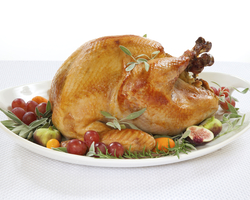
Nov. 18, 2022—It's a big job preparing a delicious Thanksgiving feast. But what if this is your first time cooking a turkey? Remember that raw poultry can increase the risk of foodborne illness. That's why it's important to handle and cook your turkey properly.
Here are answers to some questions many people have about how to prepare and cook a Thanksgiving turkey. These tips from the U.S. Department of Agriculture and the Centers for Disease Control and Prevention can help make your Thanksgiving meal safer and less stressful.
How do you thaw a turkey?
Never thaw a turkey on the kitchen counter. Any harmful bacteria in the bird can multiply quickly at room temperature. The best way to thaw your turkey depends on the size of the bird and how much time you have available. There are three safe options:
- In the refrigerator (the safest method). Put the turkey in a container to prevent any juices from touching other foods. This method takes time—about 24 hours for every 5 pounds of turkey. For large turkeys, thawing can take several days. So don't wait until the last minute!
- In a sink. Leave the turkey in its plastic wrapper, and set it in a bath of cold—not hot—water. With this method, allow about 30 minutes per pound to thaw your turkey. Change the water every 30 minutes.
- In a microwave oven. Follow your microwave's thawing instructions, and check your owner's manual for thawing times.
How do you safely prepare a turkey?
Here are a few things to keep in mind when getting your turkey ready for the oven:
- Wash your hands with soapy water for 20 seconds before and after you handle the turkey. Keep the raw turkey separate from other foods.
- Do not wash your turkey. Cooking your turkey hot enough will kill any germs. If you wash it, you could spread raw juices (and possibly bacteria) around your kitchen.
- Remove the giblets from the turkey after thawing, and cook them separately.
- Stuffing a turkey isn't recommended, for safety reasons. Even after the turkey itself is hot enough, the stuffing may not have reached a safe internal temperature. The easiest way to cook stuffing safely? In a separate casserole dish. If you do choose to stuff your turkey, add the stuffing just before you put the turkey in the oven, and always use a thermometer to confirm that the stuffing has reached 165 degrees.
How long does it take to roast a turkey?
It depends on how much your turkey weighs and what temperature you cook it at. Never cook a turkey at a temperature below 325 degrees. In general, here's how long it takes to roast an unstuffed turkey in a conventional oven at 325 degrees (for stuffed turkeys, allow at least 15 additional minutes of cooking time):
- 8 to 12 pounds: 2 3/4 to 3 hours.
- 12 to 14 pounds: 3 to 3 3/4 hours.
- 14 to 18 pounds: 3 3/4 to 4 1/4 hours.
- 18 to 20 pounds: 4 1/4 to 4 1/2 hours.
- 20 to 24 pounds: 4 1/2 to 5 hours.
How do you know when a turkey is done and safe to enjoy?
Your turkey is safely cooked only when it has reached an internal temperature of at least 165 degrees. This is hot enough to kill any bacteria that may be present. When checking for doneness, insert the thermometer in three places: the innermost part of the thigh, the innermost part of the wing and the thickest part of the breast. Use a food thermometer even if your turkey comes with a pop-up thermometer.
One last step: Let the turkey rest for 20 minutes before serving. That will allow the juices to set—and make it easier to carve.
What about the leftovers?
Refrigerate your leftover turkey within two hours. To store it safely, cut the turkey off the bone and store it in an airtight bag or container. When it's time to dig in, enjoy your turkey cold or heat it to 165 degrees. Your turkey will last for four days in your fridge and about four months in the freezer.